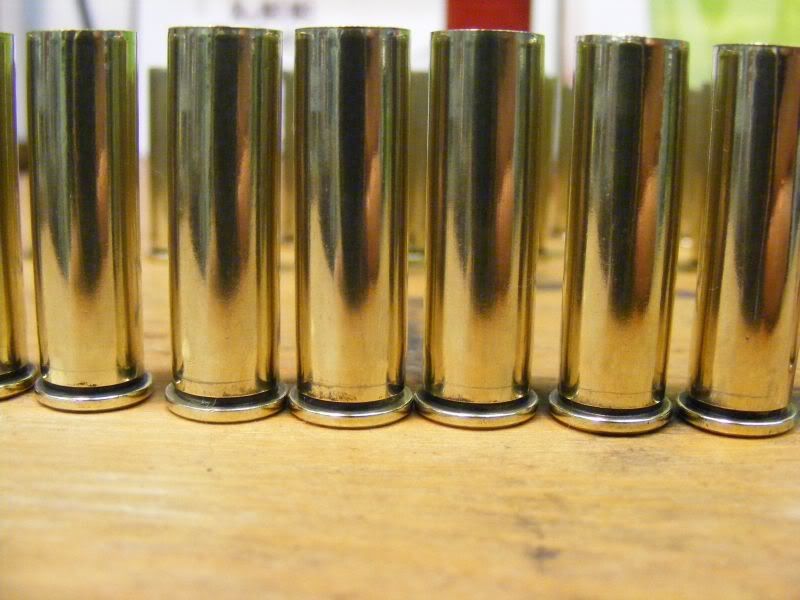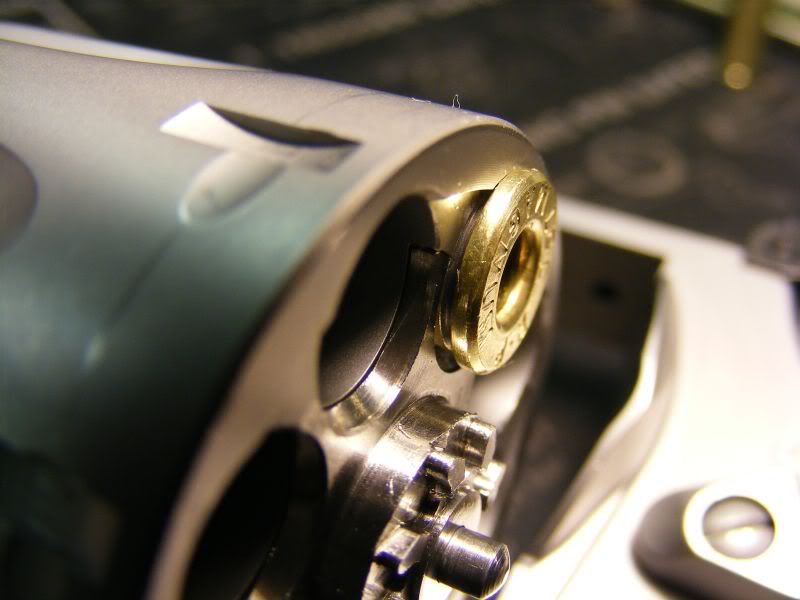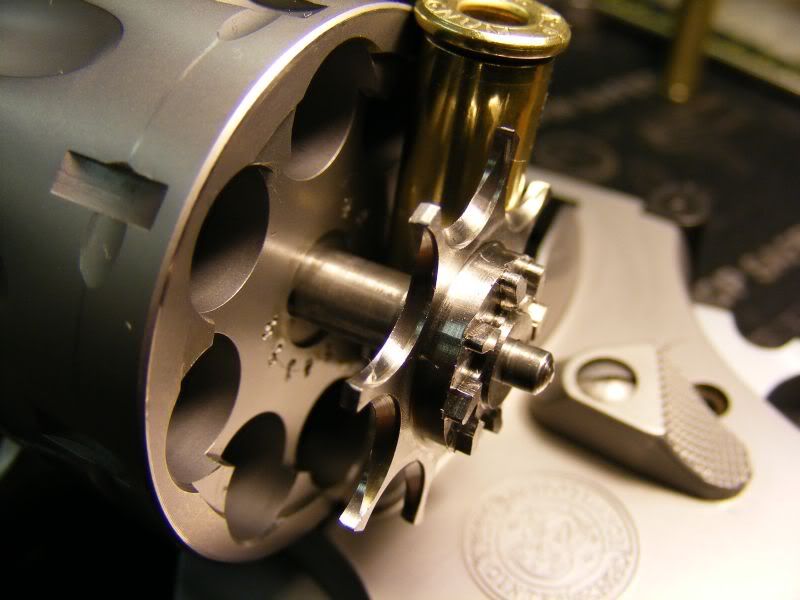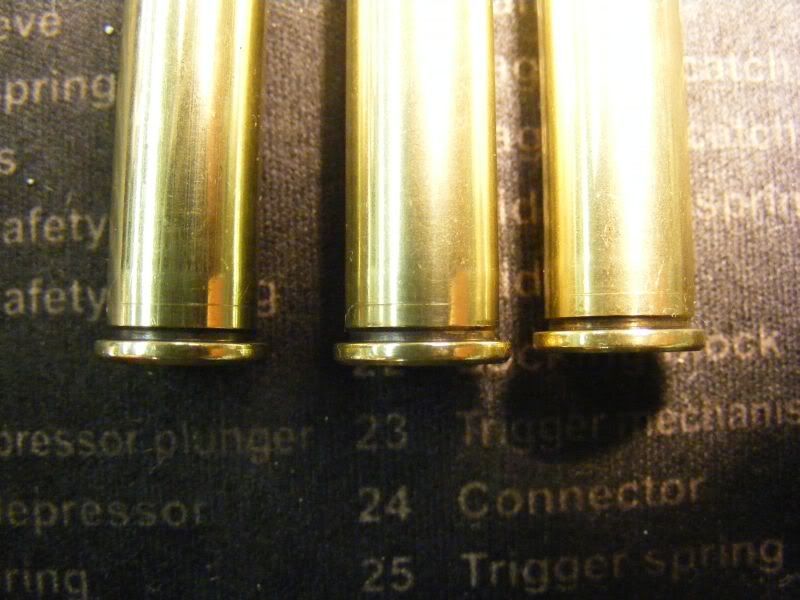|
|
 |

02-26-2012, 02:40 PM
|
|
Member
|





|
|
Join Date: Dec 2010
Posts: 158
Likes: 1
Liked 37 Times in 20 Posts
|
|
 Incipient Case Separation or Ejector Scribe Marks
Incipient Case Separation or Ejector Scribe Marks
I was inspecting .357 brass that I shot yesterday with my 627 and 686 revolvers. This is the third time this brass has been used. I shoot the 627 without the aid of moon-clips. The 686 does not support moon clips. I noticed rings about the head on most of the brass. The rings do not go completely around the case but extend for maybe 1/4" the diameter of the case. The lines are approximately 0.14" below primer side of the rim. The lines do not display the "bright ring warning sign" of case separation but rather look like scribed cuts made with a blade.
See pic

I placed an empty case in the cylinder. It appears to me that the cuts were made from the ejector. The ejector has a wedge shaped edge. The edge is sharp. The marks on the case appear to coincide with the sharp edge of the ejector. It appears that as the gasses expand the case, the case imbeds itself into the sharp edge of the ejector. The mark is then imprinted or cut into the case. Side Note: Notice there is a portion of the case that is not supported? Something to keep in mind.
See Pic
 See Pic
See Pic

Apparently, this has to weaken the head of the case. Does anyone have more information? Would you keep reloading these marked or scribed cases?

|

02-26-2012, 03:22 PM
|
 |
Member
|





|
|
Join Date: Feb 2007
Location: Oregon
Posts: 2,403
Likes: 4,558
Liked 2,141 Times in 770 Posts
|
|
Nice photos. Looks like the marks are in the area where the web is pretty thick, so I don't know how much they might actually weaken the case.
If it were my gun, I'd probably take some 600 grit paper and just barely hit that sharp edge, I'm thinking that may eliminate the scoring you see.
As an aside, I check suspect 5.56 cases with a paper clip that I've straightend out, then put a 90 degree bend in to create a leg about 1/8" long. I'll file that or clip it with diagonal cutters to make a sharp end, and then use it to feel for a ring on the inside of the case. This does seem to work pretty well.
__________________
ΜΟΛΩΝ ΛΑΒΕ
|
|
The Following User Likes This Post:
|
|

02-26-2012, 04:30 PM
|
 |
Member
|
|
|
Join Date: Feb 2006
Location: Kalif. usa
Posts: 6,836
Likes: 2,665
Liked 3,927 Times in 2,366 Posts
|
|
I doubt it's incip head sep, never seen it ever in any of my magnums & shome of the brass has been loaded a dozen times @ max levels. A IHS mark would be higher up the case. Try breaking the edge of the extractor w/ a bit of 600g cloth.
|

02-26-2012, 05:03 PM
|
 |
Member
|

|
|
Join Date: Sep 2008
Location: Northern Virginia
Posts: 41
Likes: 0
Liked 6 Times in 5 Posts
|
|
Does not look like you have an incipient separation.
You can cut one of the cases lengthwise, with a hack saw, if you are still in doubt.
The bent paper-clip suggestion is a good one.
My Model 28 had a sharp edge around the extractor that would sometimes leave scratch marks on the cases when they were ejected. I polished the area with a hard Arkansas stone. That eliminated most of that problem.
|

02-26-2012, 06:17 PM
|
 |
Member
|





|
|
Join Date: Aug 2007
Location: between beers
Posts: 8,889
Likes: 4,778
Liked 6,939 Times in 3,309 Posts
|
|
it does look like your extractor is the culprit. As to what that will do in the long run, I wish I could tell you. off the cuff I'd guess (pay attention to that choice of word) that it would have no ill effect.
If however my guess is incorrect and that scribe line isnt below the web as I suspect it will be, its well positioned for a bad scene.
I suppose you could run a smallish batch of cases like say 50 and cut a few in half for inspection on each loading cycle which might give you some hard numbers
__________________
it just needs more voltage
|

02-26-2012, 06:38 PM
|
 |
Member
|





|
|
Join Date: Jul 2010
Location: Florida
Posts: 6,619
Likes: 3,397
Liked 9,286 Times in 3,487 Posts
|
|
Straight-walled handgun cases don't "stretch" like bottle-necked rifle cases will, so it doubtful it's inpending head separation.
|

02-26-2012, 07:06 PM
|
|
Member
|





|
|
Join Date: Dec 2010
Posts: 158
Likes: 1
Liked 37 Times in 20 Posts
|
|
2hawk, you had a good idea and I ran with it.
I made the scribe gauge tool (90 deg bent paper-clip) and found that I could not get deep enough in the case to feel for any breaches (cracks) in the case. So, I did some measurements with a digital caliper on my Remington cases with the scribed lines. One of the cases I measured (mouth to Rim) had a case length of 1.2815". I then measured from the mouth to the scribed line on the outside of the case on the head. I got ~1.138". I then measured from the mouth to the case head from inside the case. I measured ~1.125". It appears that the scribed line made by the 627 is on the "meaty" part of the head and below the web. Using the calculator, it looks like my head thickness is ~ 0.1565". I think these cases are good to reload. I don't believe it's head separation either. As a precaution, I sent email to Smith and Wesson. Thanks guys .
|

02-26-2012, 07:24 PM
|
 |
Member
|

|
|
Join Date: Aug 2007
Location: Oro Valley, Arizona
Posts: 2,370
Likes: 497
Liked 943 Times in 518 Posts
|
|
I went through this issue a few months ago, and found it was NOT incipient case head separation. I cut a case , and found that the scribe mark was in the web area and there was no sign whatsoever of case thinning anywhere.
It seems that the issue was that my sizing die was screwed down too far. Here's the thread:
Case head separation: who's had it happen?
Be sure to read post #10 in this thread.
Last edited by andyo5; 02-26-2012 at 07:51 PM.
|

02-27-2012, 09:42 AM
|
|
Member
|





|
|
Join Date: Dec 2010
Posts: 158
Likes: 1
Liked 37 Times in 20 Posts
|
|

andyo5, Those marks look suspiciously similar to the marks on my cases. Your marks appear to be "jagged" while my marks are clean slice cuts. But the distance from the end of the rim is very similar. The marks on my cases never go completely around the cases circumference.
See Pic

I inspect my cases three times during the loading process. Before sizing, after sizing and after crimping. I'm always looking for defective cases. I have a Lee Breach-Lock-Classic cast single stage press. I use Lee's 4 die set #90964. In instructions for setting-up the full length sizer die instructs me to "Screw the full length sizer in until it touches the shell holder and tighten lock ring finger tight." I don't feel any "bump" at the end of the downward stroke of the press handle. I do feel a bit of resistance just before the primer pops out. What die set are you using? How far off from the shell holder do you set your sizing die?
Initially, I thought maybe the sizing die or sizing die adjustment was the problem. I separated the expended (fired) cases without the scribe marks from those that had the scribe marks. I ran the expended cases without the scribe marks through the full length sizing die. None of the cases that didn't display the scribe marks received scribe marks.

|

02-27-2012, 02:00 PM
|
|
SWCA Member
|





|
|
Join Date: Mar 2009
Location: Central Kentucky
Posts: 691
Likes: 184
Liked 514 Times in 106 Posts
|
|
I've had the exact same problem with some 357 mag brass. I traced it to the sizing die on my Dillon SDB. Called Dillon and they sent me another sizing die and the problem went away.
I suggest checking the sizing die with the reloading set up you use.
__________________
SWCA #2421
|

02-27-2012, 05:31 PM
|
|
Member
|





|
|
Join Date: Jun 2010
Location: Maine
Posts: 3,065
Likes: 24,860
Liked 5,784 Times in 1,280 Posts
|
|
when a case separates on fireing it will be "smoked up" in that area - there will be no doubt in your mind what just happened - I like the 600 grit idea, but might use something even finer, might even hit the die a little too
|

02-27-2012, 05:46 PM
|
 |
Member
|

|
|
Join Date: Aug 2007
Location: Oro Valley, Arizona
Posts: 2,370
Likes: 497
Liked 943 Times in 518 Posts
|
|
Gsperesa, I am using Dillon dies on a Dillon 550 press.
I will try sizing a new case with the die all the way down to check for marks.
|

02-28-2012, 12:35 AM
|
 |
Member
|





|
|
Join Date: Jan 2007
Location: Sandy Utah
Posts: 8,739
Likes: 1,587
Liked 8,893 Times in 3,546 Posts
|
|

gsparesa,
What you have is exactly what andy05 tells you it is. Inexperienced reloaders when first using carbide sizing dies typically just screw them down until they touch the shell holder. This puts them so far down that the case is pushed into the die deep enough that the solid head of the case is sized, which leaves a small, but distinct, ring around the case exactly where you are seeing it.
Some manufacturers make dies with a tapered entry so they will not damage a case this way. Simpler is to simply raise the sizer die 1-2 turns away from the shell holder and your "problem" will go away.
Another approach is Redding's new "Dual Ring" size die. Dual Ring Carbide Dies | Redding Reloading Equipment: reloading equipment for rifles, handguns, pistols, revolvers and SAECO bullet casting equipment Kind of pricey at $144. You can do the same thing by just sizing the mouth (Neck sizing) of your cases as deep as the bullet seats, then using the Lee "Carbide Factory Crimp Die" to crimp your loads and post-size the body of the case to maximum SAAMI diameter instead of under the minimum tolerance as a standard carbide does when used for full-length sizing. This results in over working your brass and early case splitting. The Lee die costs about $20, and is one of the best ideas Lee any reloading tool manufacturer has ever come up. It does have its' limitations.
__________________
Gunsmithing since 1961
Last edited by Alk8944; 02-28-2012 at 12:40 AM.
|

02-28-2012, 02:56 AM
|
 |
Member
|
|
|
Join Date: Feb 2006
Location: Kalif. usa
Posts: 6,836
Likes: 2,665
Liked 3,927 Times in 2,366 Posts
|
|
Quote:
Originally Posted by SMSgt

Straight-walled handgun cases don't "stretch" like bottle-necked rifle cases will, so it doubtful it's inpending head separation.
|
They actually do stretch & quite a bit depending on pressures. All rimmed cases do. I have just never seen a reovler case separate, but could happen w/ a revolver that has excessive headspace.
|

02-28-2012, 03:42 AM
|
|
Member
|





|
|
Join Date: Dec 2011
Location: Northern California
Posts: 23
Likes: 9
Liked 3 Times in 3 Posts
|
|
Quote:
Originally Posted by fredj338

They actually do stretch & quite a bit depending on pressures. All rimmed cases do. I have just never seen a reovler case separate, but could happen w/ a revolver that has excessive headspace.
|
If the revolver had, as you say, "excessive headspace" what would be the solution in eliminating this situation and returning the revolver to "normal headspace?"
|

02-28-2012, 04:40 PM
|
|
Member
|
|
|
Join Date: Oct 2006
Posts: 6,649
Likes: 1,819
Liked 5,406 Times in 2,726 Posts
|
|
Excessive headspace in revolvers is generally the result of excessive endplay. It also isn't really an issue at the pressure levels of non-magnum revolver cartridges, as the chamber is free to move on the front-to-rear axis.
Case stretch in straight wall pistol cartridges is generally the result of repeated firing/sizing cycles that, over time, causes the brass to extrude lengthwise.
Last edited by WR Moore; 02-28-2012 at 04:44 PM.
|
 |
|
Tags
|
627, 686, crimp, ejector, extractor, lock, model 28, primer, remington, sig arms, smith and wesson, smith-wessonforum.com  |
 Posting Rules
Posting Rules
|
|
|
|
|
